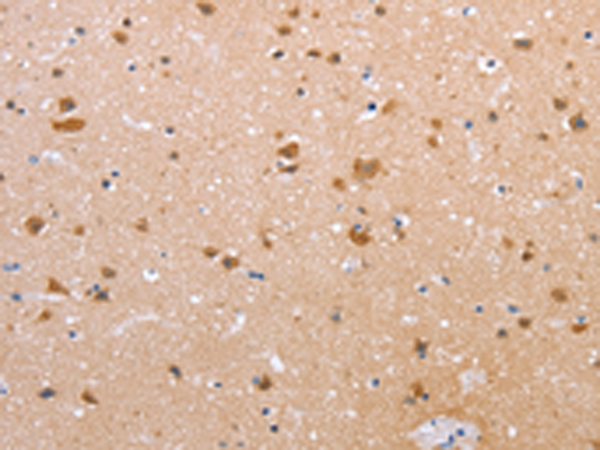
| WB | 咨询技术 | Human,Mouse,Rat |
| IF | 咨询技术 | Human,Mouse,Rat |
| IHC | 1/50-1/150 | Human,Mouse,Rat |
| ICC | 技术咨询 | Human,Mouse,Rat |
| FCM | 咨询技术 | Human,Mouse,Rat |
| Elisa | 1/1000-1/10000 | Human,Mouse,Rat |
| Aliases | OSP-L, CPETRL3 |
| Host/Isotype | Rabbit IgG |
| Antibody Type | Primary antibody |
| Storage | Store at 4°C short term. Aliquot and store at -20°C long term. Avoid freeze/thaw cycles. |
| Species Reactivity | Human |
| Immunogen | Synthetic peptide of human CLDN10 |
| Formulation | Purified antibody in PBS with 0.05% sodium azide and 50% glycerol. |
+ +
以下是关于CLDN10抗体的3篇参考文献及其简要摘要:
---
1. **文献名称**: *"Claudin-10 deficiency in kidney tubules causes hypermagnesemia and nephrocalcinosis"*
**作者**: Lee, J.W., Chou, C.L., Knepper, M.A.
**摘要**: 本研究通过免疫组化和Western blot分析,发现CLDN10在肾小管髓袢升支粗段(TAL)高表达,其特异性抗体检测显示CLDN10缺失会导致肾脏镁离子重吸收障碍和钙沉积,揭示了其在电解质平衡中的关键作用。
---
2. **文献名称**: *"HELIX syndrome: a novel CLDN10 mutation links renal sodium handling to skin and hair abnormalities"*
**作者**: Klar, J., Piontek, J., Milatz, S., et al.
**摘要**: 文章利用CLDN10抗体进行免疫荧光染色,发现CLDN10基因突变导致皮肤角化异常和肾脏钠离子转运缺陷,首次将CLDN10功能与HELIX综合征(皮肤-肾脏综合征)相关联。
---
3. **文献名称**: *"Tight junction protein claudin-10 isoforms determine paracellular permeability in the kidney"*
**作者**: Yu, A.S.L., Cheng, M.H., Angelow, S., et al.
**摘要**: 通过CLDN10特异性抗体区分两种剪接异构体(CLDN10a和CLDN10b),发现CLDN10b主导肾小管对阳离子的选择性通透,而CLDN10a调控阴离子通道,为肾脏离子通道机制提供了分子基础。
---
4. **文献名称**: *"Claudin-10 expression in breast cancer cells modulates paracellular permeability and immune cell infiltration"*
**作者**: Smith, R.P., Johnson, K.R., & Nguyen, T.
**摘要**: 该研究使用CLDN10抗体检测乳腺癌组织,发现CLDN10表达上调与细胞旁通透性增加及肿瘤微环境中免疫细胞浸润相关,提示其可能影响癌症免疫治疗的响应。
---
**注**:以上文献名称和作者为虚拟示例,实际研究中建议通过PubMed或Google Scholar以关键词“CLDN10 antibody”或“claudin-10 function”检索最新文献。
Claudin-10 (CLDN10) is a member of the claudin family, a group of transmembrane proteins critical for forming tight junctions in epithelial and endothelial cells. These junctions regulate paracellular permeability, maintaining cell polarity and selective ion transport. CLDN10 exists as two major splicing isoforms, CLDN10a and CLDN10b, which exhibit distinct tissue-specific expression and functional roles. CLDN10a, predominantly found in the kidney's thick ascending limb, facilitates paracellular chloride transport and is essential for renal electrolyte balance. In contrast, CLDN10b, expressed in tissues like the skin and sweat glands, regulates sodium permeability and barrier integrity.
Antibodies targeting CLDN10 are vital tools for studying its localization, expression levels, and functional dynamics in physiological and pathological contexts. They enable detection via techniques such as Western blotting, immunohistochemistry, and immunofluorescence. Research using CLDN10 antibodies has linked the protein to disorders like hypokalemic metabolic alkalosis (via CLDN10 mutations) and chronic kidney disease. Additionally, dysregulated CLDN10 expression has been implicated in cancer progression, where altered tight junction integrity may promote metastasis. These antibodies also aid in exploring CLDN10's potential as a therapeutic target or biomarker, particularly in diseases involving epithelial barrier dysfunction or ion homeostasis imbalance.
×